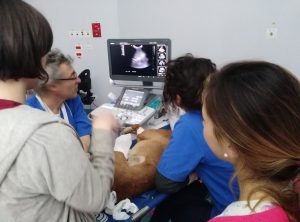Enhanced fibrinolysis detection in a natural occurring canine model with intracavitary effusions: Comparison and degree of agreement between thromboelastometry and FDPs, D-dimer and fibrinogen concentrations.
Zoia A1, Drigo M2, Piek CJ3, Calcini H1, Caldin M4, Simioni P5.
scarica gratuitamente l’articolo intero
Abstract
Dogs with intracavitary effusion have coagulative abnormalities indicative of primary fibrinolysis/hyperfibrinolysis. The aim of this case control study was to investigate by rotational thromboelastometry (ROTEM) and standard coagulation tests (fibrin-fibrinogen degradation products, D-dimer and fibrinogen) fibrinolysis in dogs with intracavitary effusions. Thirty-two dogs with intracavitary effusion and 32 control sick dogs without effusion were studied. Frequency of fibrinolysis grade of severity (i.e., hypofibrinolysis/basal fibrinolysis vs increased fibrinolysis vs hyperfibrinolysis) by ROTEM and standard coagulation tests were compared between groups. Pattern of fibrinolysis by ROTEM (i.e., late vs intermediate vs fulminant) and type of fibrinolysis by standard coagulation tests (i.e., hypofibrinolysis/basal fibrinolysis vs primary fibrinolysis vs secondary fibrinolysis vs primary hyperfibrinolysis vs secondary hyperfibrinolysis) were also compared between groups. Dogs with intracavitary effusion had a lesser degree of hypofibrinolysis and basal fibrinolysis and a higher degree of increased fibrinolysis and hyperfibrinolysis compared to controls, both by ROTEM and by standard coagulation tests (P = 0.042 and P = 0.017, respectively). Nevertheless, there was a poor agreement between the two classification schemes (34.4%, K = 0.06, 95% CI = -0.14 ‒ +0.26). Dogs with intracavitary effusion showed, by ROTEM, a lesser degree of hypofibrinolysis and basal fibrinolysis and a higher degree of late, intermediate, and fulminant fibrinolysis compared to controls (P = 0.044). Finally, dogs with intracavitary effusion had, by standard coagulation tests, a higher frequency of primary fibrinolysis and primary hyperfibrinolysis and a lower frequency of secondary fibrinolysis compared to controls. Dogs with intracavitary effusion showed an increased frequency and a different and more severe pattern of fibrinolysis compared to controls.






 Il Direttore Sanitario Dott. Marco Caldin
Il Direttore Sanitario Dott. Marco Caldin